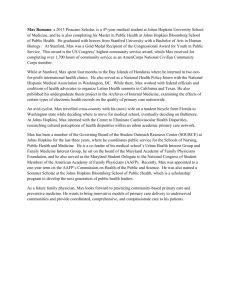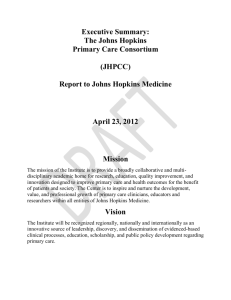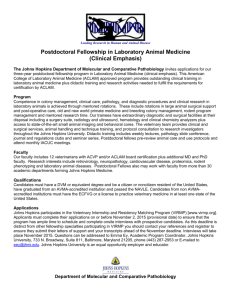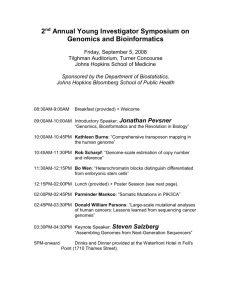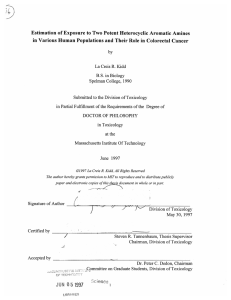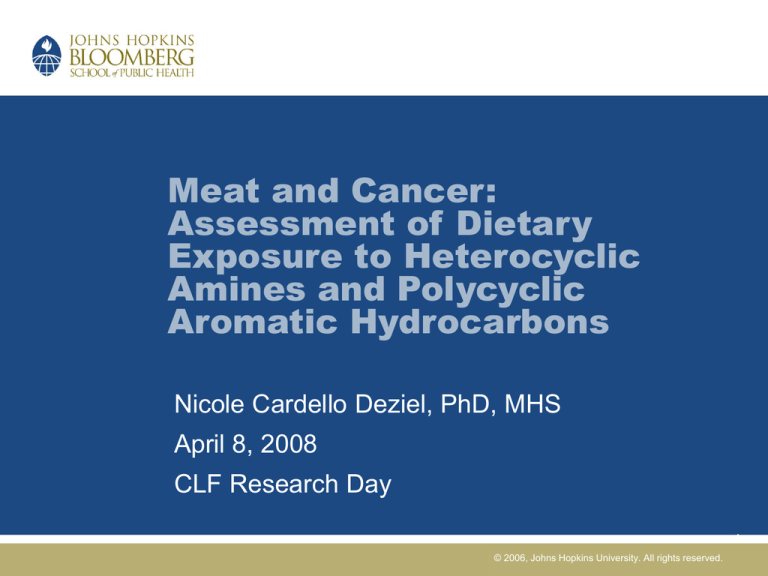
Meat and Cancer:
Assessment of Dietary
Exposure to Heterocyclic
Amines and Polycyclic
Aromatic Hydrocarbons
Nicole Cardello Deziel, PhD, MHS
April 8, 2008
CLF Research Day
© 2006, Johns Hopkins University. All rights reserved.
Introduction
• Meat intake associated with cancer (Norat and Riboli 2001; Norat et
al. 2002)
• Biological mechanism not known
• Epidemiological studies of exposure to polycyclic aromatic
hydrocarbons (PAH) and heterocyclic amines (HCA) and
cancer suggestive but inconsistent
• Inconsistencies may be due to measurement error (Butler et al.
2003; Cantwell et al. 2004)
• Little known about how standard method compares to other
methods, particularly biological monitoring (Sinha et al. 2001; Butler
et al. 2003; Sinha et al. 2005; Gunter et al 2005; Cross et al. 2005, 2006; Li et al.
2007)
©©2006,
2005,Johns
JohnsHopkins
HopkinsUniversity.
University.AllAllrights
rightsreserved.
reserved.
Objective
To evaluate dietary exposure to the HCA 2-amino-1-methyl-6phenyl-imidazo-[4,5b]pyridine (PhIP) and the PAHs pyrene and
benzo[a]pyrene (BaP) using three approaches:
(1) Meat-specific food frequency questionnaire (FFQ)
combined with a food carcinogen database called
CHARRED developed by the National Cancer Institute
(NCI)
(2) NCI meat-specific diet diaries and CHARRED
database
(3) Repeated biological monitoring of HCA and PAH
urinary excretion products
© 2005, Johns Hopkins University. All rights reserved.
Methods
Population: 54 controls from a colorectal adenoma case-control
study. Exclusion criteria: smoker or live with smoker, occupational
exposure to PAH
FFQ Collection and Analysis: FFQ collected at 2 time points over
an approximate 1-year period. Combined with NCI food carcinogen
CHARRED database to estimate exposure to PhIP and BaP.
Diet Diary Collection and Analysis: Diet diaries collected at 3 time
points over an approximate 1-year period. Combined with
CHARRED database to estimate exposure to PhIP and BaP.
Urine Collection and Analysis: Overnight voids collected at 3 time
points concurrent with diet diaries. Urine analyzed for PhIP and its
conjugates and 1-hydroxypyrene-glucuronide (1-OHPG). Urinary
cotinine assessed to confirm non-smoking status.
© 2005, Johns Hopkins University. All rights reserved.
NCI Meat-Specific FFQ
© 2005, Johns Hopkins University. All rights reserved.
Methods: FFQ Photographs
© 2005, Johns Hopkins University. All rights reserved.
Results: HCA
0
10
20
30
40
Urinary PhIP vs. Diary-Based PhIP
0
200
400
Mean PhIP Estimated from Diaries (ng/day)
600
© 2005, Johns Hopkins University. All rights reserved.
Results: HCA
r=0.81
p<0.05
0
5
10
15
Urinary PhIP vs. Diary-Based PhIP, No Zeros
0
200
400
Mean PhIP Estimated from Diaries (ng/day)
600
© 2005, Johns Hopkins University. All rights reserved.
Results: PAH
Spearman correlations between urinary 1-OHPG (ng) and
BaP intake (ng/day) estimated from diet diaries excluding
participants with elevated urinary cotinine
Diet
Diaries
Collect. 1
Diet
Diaries
Collect. 2
Diet
Diaries
Collect. 3
1-OHPG Collect. 1
0.36*
0.35*
0.22
1-OHPG Collect. 2
0.13
0.21
0.19
1-OHPG Collect. 3
-0.06
0.32*
0.33*
Mean All Collect.
Mean of All
Diaries
0.59**
*p<0.1 **p<0.05
© 2005, Johns Hopkins University. All rights reserved.
Results: PAH
Spearman correlations between urinary 1-OHPG and BaP intake
(ng/day) estimated from FFQs
1-OHPG
Collect. 1
1-OHPG
Collect. 2
1-OHPG
Collect. 3
Mean All
Collect.
FFQ Baseline
0.42**
-0.01
-0.04
0.39**
FFQ Follow-up
0.23
-0.23
0.02
0.12
Mean FFQ
0.28
**p<0.05
© 2005, Johns Hopkins University. All rights reserved.
Conclusions
• Among the three approaches for assessing dietary HCA exposure, a
correlation was only observed between the diary-database and urinary
PhIP, when the analysis was restricted to values above zero or the
detection limit (Spearman r=0.81, p<0.001).
• Lack of correlation may be due to small number of sampling days or
short-comings of the FFQ and CHARRED database.
• For PAHs, the between-method correlation was strongest for BaP intake
estimated from the diary-database and urinary 1-OHPG, after excluding
participants with evidence of tobacco smoke exposure (elevated urinary
cotinine) (Spearman r=0.59, p<0.05).
• Dietary BaP exposure estimated from the FFQ-database was also
statistically significantly correlated with urinary 1-OHPG (Spearman r =
0.39, p<0.05).
• Further examination of discrepancies between the different methods may
provide insight into ways to improve the dietary exposure assessment of
PAH and HCA.
©©2006,
2005,Johns
JohnsHopkins
HopkinsUniversity.
University.AllAllrights
rightsreserved.
reserved.
Significance for Public Health and Sustainability
• 35% of all cancer deaths in the U.S. are potentially avoidable
through dietary changes (Doll and Peto 1981, Willett 1995)
• Improved exposure assessment methods could be applied in
future epidemiological and risk studies to better understand
the diet-disease link
• The growing awareness that a diet high in meat is
deleterious to one’s health may be a powerful motivator for
change, leading the way to decreased meat consumption
• Decreased consumption could lead to decreased production,
guiding us toward a more livable future
©©2006,
2005,Johns
JohnsHopkins
HopkinsUniversity.
University.AllAllrights
rightsreserved.
reserved.
Acknowledgements
Advisor: Dr. Paul Strickland
Co-Advisor: Dr. Tim Buckley
Colorectal Adenoma Study Team
Dr. Elizabeth Platz (Principal
Investigator)
Kathy Schultz, RN
Johns Hopkins Center for a
Livable Future
National Institute for Occupational
Safety and Health
Maryland Cigarette Restitution Fund
at Johns Hopkins
Julitta Brannock
Katie Sutcliffe
Dr. Strickland’s Lab
Salah Abubaker
National Cancer Institute
Dr. Rashmi Sinha
© 2005, Johns Hopkins University. All rights reserved.


